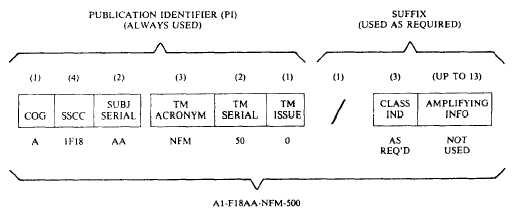Home > Aviation Maintenance Manuals > Administration Maintenance Administration 3 & 2 > The First Group (Tm Acronym)

Figure 3-3.-TMINS example.
set), it will represent the item throughout its life cycle.
Look at figure 3-3. You can see that the first seven characters of the PI are divided into three groups. The first group (COG) of the PI is a single letter that tells what command is responsible for publishing and updating the publication. For example, in figure 3-3, the COG is A for NAVAIRSYSCOM.
The second group, standard subject classification code (SSCC), is a four-digit alphanumeric code that identifies the commodity or subject matter; for example, in figure 3-3, the 1 in 1F18 indicates aircraft or aviation. The F18 stands for the F-18 aircraft.
The third group, subject serial code, is a two-digit code (either numbers, letters, or both) that is assigned by the Naval Air Technical Services Facility (NAVAIRTECHSERVFAC) for aeronautical manuals. It differentiates between items assigned to a given SSCC series or subseries. The subject serial codes related to aircraft are assigned according to aircraft model designation, the first being AA and the second AB. For example, the subject serial code for aircraft model A-6A is AA, aircraft model A-6B is AB, and aircraft model A-6C is AC. The subject serial codes may not be in the same sequence as the aircraft model designations. The serial codes will normally be in the sequence of each subsequent approved model designation. In figure 3-3, the subject serial code AA has been assigned for the F/A-18A aircraft.
The remaining six characters of the PI are called the technical manual (TM) identifier. The six characters identify a particular TM and are divided into three groups.
The first group (TM acronym) consists of three letters or numbers. These letters or numbers identify the type of manual; for example, in figure 3-3, the TM acronym NFM identifies the manual as a NATOPS flight manual supplement. Numerically, they can identify the first three digits of a particular work unit code; for example, 520 is an autopilot. In some instances of work unit codes, such as support equipment (SE), a combination of a letter and two numbers is used for the TM acronym; for example, S14 is an air compressor.
The second group of the TM identifier (TM serial number) is made up of two numbers. It is used to identify different volumes, parts, and changes to specific TMs. For NAVAIR TMs, these numbers range from 00 through 99. In the example shown in figure 3-3, the TM serial number is 50. This stands for a Pilots Pocket Checklist.
The third group of the TM identifier is the TM issue, and is either a number (0 to 9) or a single letter. The number indicates the TM is a basic issue or superseding revision. A letter (A to Z except I and O) designates (in alphabetical sequence) permanent changes or rapid action changes (RACs) assigned by order of date issued.
PI SUFFIX COMPOSITION. - The PI suffix has a variable composition, depending upon
Continue Reading